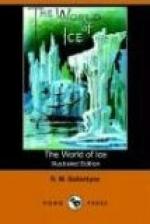“I don’t know,” replied Singleton, “it has long been a matter of dispute among learned men. But we must examine it for ourselves, so come along.”
The remarkable colour of the snow referred to, although a matter of dispute at the period of the Dolphin’s visit to the Arctic Seas, is generally admitted now to be the result of a curious and extremely minute vegetable growth, which spreads not only over its surface, but penetrates into it sometimes to a depth of several feet. The earlier navigators who discovered it, and first told the astonished world that the substance which they had been accustomed to associate with the idea of the purest and most radiant whiteness had been seen by them lying red upon the ground, attributed the phenomenon to innumerable multitudes of minute creatures belonging to the order Radiata; but the discovery of red snow among the central Alps of Europe, and in the Pyrenees, and on the mountains of Norway, where marine animalcula could not exist, effectually overturned this idea. The colouring matter has now been ascertained to result from plants belonging to the order called Algae, which have a remarkable degree of vitality, and possess the power, to an amazing extent, of growing and spreading with rapidity even over such an ungenial soil as the Arctic snow.
While Singleton was examining the red snow, and vainly endeavouring to ascertain the nature of the minute specks of matter by which it was coloured, Fred continued to gaze with a look of increasing earnestness towards the tall column, around which a bank of fog was spreading, and partially concealing it from view. At length he attracted the attention of his companion towards it.
“I say, I’m half inclined to believe that yon is no work of nature, but a monument set up to attract the attention of ships. Don’t you think so?”
Singleton regarded the object in question for some time. “I don’t think so, Fred; it is larger than you suppose, for the fog-bank deceives us. But let us go and see; it cannot be far off.”
As they drew near to the tall rock, Fred’s hopes began to fade, and soon were utterly quenched by the fog clearing away, and showing that the column was indeed of nature’s own constructing. It was a single, solitary shaft of green limestone, which stood on the brink of a deep ravine, and was marked by the slaty limestone that once encased it. The length of the column was apparently about five hundred feet, and the pedestal of sandstone on which it stood was itself upwards of two hundred feet high.
This magnificent column seemed the flag-staff of a gigantic crystal fortress, which was suddenly revealed by the clearing away of the fog-bank to the north. It was the face of the great glacier of the interior, which here presented an unbroken perpendicular front—a sweep of solid glassy wall, which rose three hundred feet above the water-level, with an unknown depth below it. The sun glittered on the crags and peaks and battlements of this ice fortress, as if the mysterious inhabitants of the Far North had lit up their fires and planted their artillery to resist further invasion.




